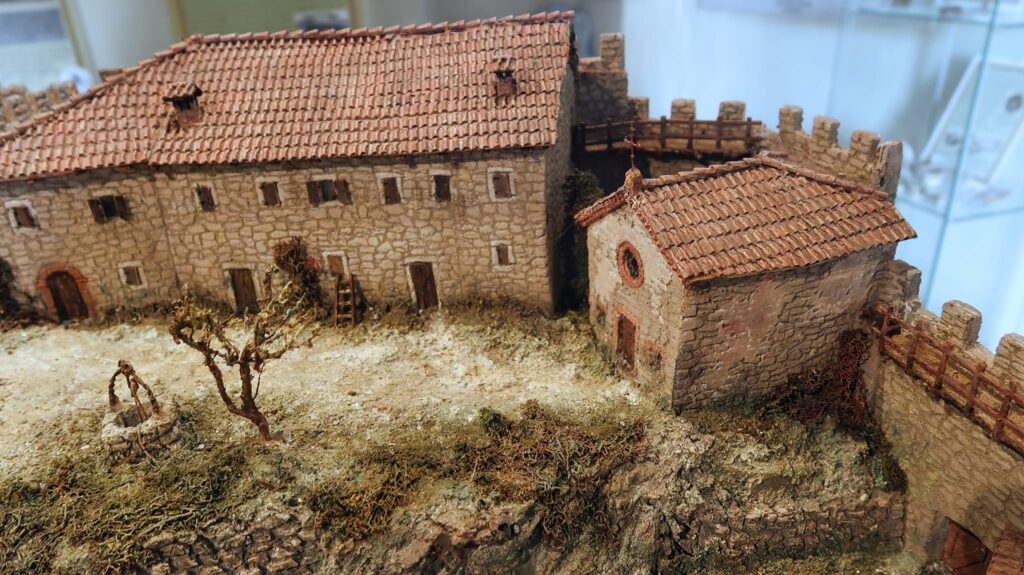
Il 21 febbraio 1609 nasceva nel nostro Castello quel Raimondo Montecuccoli che sarebbe poi divenuto uno dei più grandi personaggi della Storia d’Europa, nonchè militare tra i più geniali di tutti i tempi. La leggenda vuole che il piccolo, figlio del Conte Galeotto e dalla Contessa Anna Bigi, sia nato nella stanza al secondo piano, del torrione di piazza; ma probabilmente essa nasce unicamente dal fatto, che detta stanza è l’unica che conserva gli affresci rinascimentali e quindi è la più bella di tutta la rocca. Il Conte Montecuccoli mandò immediatamente a prendere l’arciprete di Renno, in modo che venisse a battezzare il piccolo, per evitare che qualora non fosse sopravvissuto, dovesse perire senza aver ricevuto il sacramento. Il battesimo avvenne all’interno del Castello, nella cappella privata della famiglia Montecuccoli. Quando assieme all’artista Giuseppe Ricci, abbiamo progettato il modellino del Castello, che lo raffigura come poteva apparire in quel 1609, quando nacque Raimondo, si è posto per noi, il problema di come raffigurare quelle parti che non ci sono più e di cui non disponiamo di fotografie d’epoca. In nostro soccorso, è venuto un appunto di Luigi Serafino Parenti, governatore di Montecuccolo alla fine del XVIII° secolo, che Venceslao Santi rinviene, durante la redazione di un articolo, che tratta la corrispondenza di quest’ultimo con lo storico modenese Girolamo Tiraboschi. : “In una lapida in una muraglia annessa al quartiere (la caserma dei soldati), e che sostenta la cappellina, si legge: M. DC. VIII – CO. GALEOTUS – M.s (cioè Monticuculus) A. FUDAMEN – TIS. AUGENDO – RESTITUIT”.Ovvero, la cappellina, che un altro documento descrive come posta a levante, era annessa alla caserma dei soldati (la quale a sua volta si sviluppava lungo le mura nord a destra della Torre mastio) e aveva una lapide che ne descriveva il restauro da parte del Conte Galeotto Montecuccoli nell’anno 1608, ovvero poco prima del battesimo di Raimondo. Della cappella si riteneva che fosse andata persa ogni traccia, fino a quando lo scorso anno abbiamo fatto un rinvenimento sensazionale, manufatto che, confidando nella collaborazione dell’amministrazione comunale del Comune di Pavullo nel Frignano intendiamo valorizzare e consegnare alla comunità all’interno del Castello nella sezione Museale dedicata a Raimondo Montecuccoli, quale ulteriore testimonianza e ricordo della sua nascita nel nostro territorio.
testo e photo Alessio Bononcini – modellino Giuseppe Ricci.
bibliografia:
Andrea Pini “Montecuccolo, la storia svelata. I signori, la rocca, i feudi”, Adelmo Iaccheri La Sorgente, 1999
Berardo Rossi, “Raimondo Montecuccoli, un cittadino dell’Europa del Seicento”, edizioni Digigraf, 2002.
Venceslao Santi “Corrispondenza tra Girolamo Tiraboschi, L.S.Parenti e A.P.Ansaloni pubblicata a cura della R. Deputazione di Storia patria per le provincie Modenesi nel primo centenario della morte di Girolamo Tiraboschi – Modena, Vincenzi, 1894
